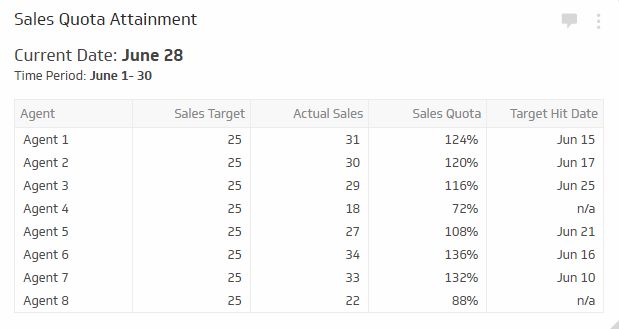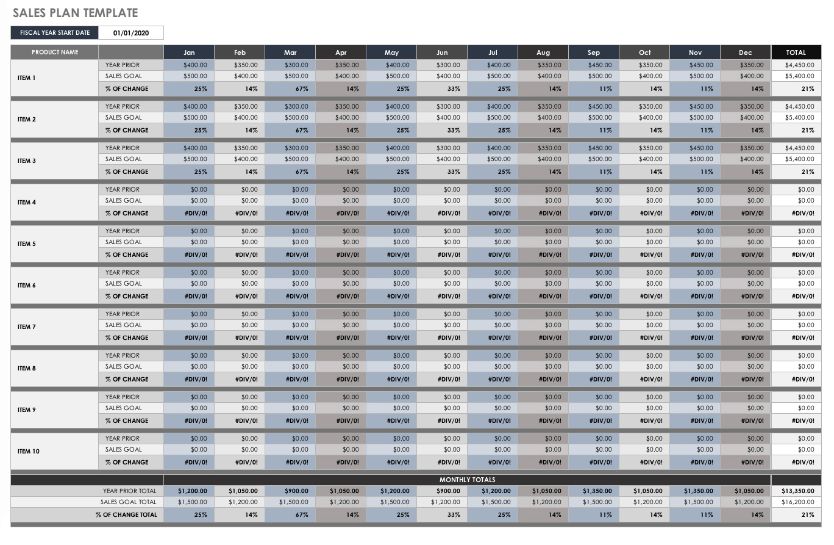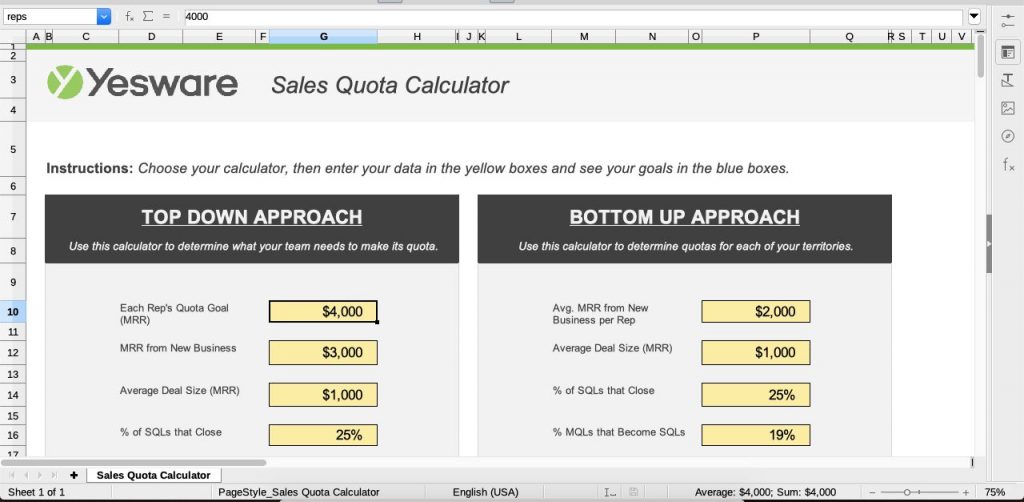It is very important to establish realistic and ambitious sales quotas. These quotas can keep your sales team motivated, and it helps you predict and reach your company’s revenue and growth goals.
So how can you craft a quota that perfectly balances your company’s needs and your sales team’s capabilities? And what exactly is a sales quota?
What Is a Sales Quota?
A sales quota is the number of sales you expect from an agent or team during a determined time frame. These sales quotas are usually developed by a sales analyst.
Sales quotas can be measured during days, weeks, months or even years. During that time, a quota can be measured by different factors, such as overall profit, units sold, and customers acquired. The right time frame and measurement tool will depend on a company’s needs and business model.
Companies use sales quotas to establish what success looks like for their reps clearly. They usually reward successful sales reps that have achieved their sales quotas with bigger commissions or other prizes, to keep them motivated.
Companies also use quotas to measure their success and predict their expected revenue and sales volume.
Sales Quotas vs Sales Targets & Goals: What’s the Difference?
While sales quotas are the same as sales targets, they’re not the same as sales goals. Since both quotas and sales goals refer to a future, sales-related objective, they can often be confused.
The difference between sales quotas and sales goals is that sales quotas are metrics specifically focused on revenue, such as selling a specific amount of product by the end of the month. Meanwhile, sales goals refer to a more holistic approach, such as expanding sales efforts to a new demographic or implementing new sales programs. The marketing department and business development representatives usually manage sales goals.
A sales quota is time-sensitive and measured by a specific metric. However, sales goals can be treated as overall objectives that will develop projects and strategies around sales. Sales teams use quotas as part of the sales objective. One example would be a quota of X customers that will complete the sales goal of new market penetration.
While a sales quota is a fixed number in a fixed timeframe, a sales goal can be more of an overall objective of marketing and sales teams.
These Are the Different Types of Sales Quotas (incl. Sales Quota Examples)
Your ideal sales quota will differ depending on your business model and the product or service you offer. These are the types of sales quotas and what they measure…
1. Profit or Revenue Quotas
This is the most common type of sales quota. With this quota, your sales reps are expected to sell enough products or services to reach a fixed amount of profit or revenue.
This type of quota doesn’t reward the number of products sold. Instead, it rewards the amount of money made from them. This differentiation encourages sales reps and account executives to upsell their current customers, to get the most amount of revenue per transaction.
For example, perhaps X product generates $10 of revenue, and Y product only generates $5 of revenue. If so, a sales rep may try to focus on selling more of X and less of Y, to achieve their profit quota.
Revenue quotas may prioritize profits over the number of units sold or newly acquired customers.
2. Volume Quotas
Revenue profit quotas measure how much sales reps make for the company, while volume quotas measure how much they sell overall. They’re measured according to the number of products or services the sales reps have sold or the net income they’ve generated.
For example, a subscription-based product may reward their sales reps for how many subscriptions they’ve sold during the month.
Volume quotas are often easier to calculate than profit ones. They’re also usually more transparent and easier to understand. These quotas help motivate sales reps to sell as much as possible, regardless of each item’s individual profit.
3. Activity Quotas
Another way to measure a sales rep’s effectiveness is with sales activity quotas. These quotas measure how many actions a sales rep has taken towards a sale, such as sales calls, number of leads reached, or number of new potential clients acquired.
While volume and profit quotas measure successful sales, activity quotas measure how often each sales rep works towards a sale, regardless of whether the sale is completed.
Sales activity quotas are great ways to measure how often each sales rep takes action and their engagement with the company. These quotas can be particularly useful for identifying commitment to the job, not just the sales rep’s profitability.
4. Combination Quotas
Combination quotas often measure sales reps’ activity and profitability. For example, a combination quota may consist of landing ten potential new customers and closing the sale with an average of two of the ten.
At first glance, combined quotas may seem more integral and holistic. However, they can become problematic if you measure too many metrics in the same quota. A sales rep may stress over their ratio of sales per client and lose focus on their main goal.
It’s often better to use a few metrics separately and combine them at the end. Then, you can properly measure the sales rep’s effectiveness rather than trying to combine them all into one metric.

3 Sales Quota Templates to Use
Want to measure your sales quotas? These three templates can help you start right away…
1. Sales Quota Attainment, by Klipfolio

Kilpfolio has a simple but very effective template for measuring your sales quotas. In a spreadsheet, you fill in the names of your agents and their quotas in order to compare their actual sales. This tactic allows you to have custom quotas with individual time frames for each sales rep, in order to measure them individually. It’s also an easy way to edit.
This option is great if you’re looking for a template that’s very simple to use and understand—without any complex formulas or jargon.
2. Sales Plan Template – by Smartsheet

With this template from Smartsheet, you can plan your monthly quotas and see your yearly progress in one glance. Its focus on yearly progress also allows you to compare your current year’s performance with how you did last year and add up your monthly progress.
Since it’s an Excel spreadsheet, you can easily edit any of it directly from your computer— without depending on any internet connection.
This template is perfect for measuring sales reps with low turnover rates, identifying annual and seasonal trends, and preparing predictive sales quotas accordingly.
3. Yesware sales quota calculator

Lastly, if you want to calculate your sales quota, Yesware has created a calculator to find out the ideal one for you. With it, you can calculate the right quota—either with a top-down approach or bottom-up approach. Just add your information (such as your sales goals, number of sales reps, and average sale size), and the calculator will tell you how many monthly sales, new customers, and revenues your sales reps need to generate.
This calculator is perfect for anyone who wants to find the best way to reach their sales goals on time.
Setting a Motivating (but Realistic) Sales Quota: Here’s How to Do It
A realistic quota for your sales pipeline is one that at least 80% of your sales team can meet. Here’s the way to set sales quotas for your sales reps…
1. Start with your baseline.
You need to know where you’re standing to find out how you’ll reach your goals. So you need to start defining the right type of sales quota by finding out your baseline.
A baseline defines your company’s minimum amount of sales. To establish a realistic baseline, you need to base it on your data. And to predict sales amount and fluctuation, look at your sales prospecting and long-term metrics. With this information, you can start drafting the right sales quotas for every month.
Then factor in how much your sales team would need to sell, in order to grow. Make sure you keep it realistic by taking into account your company’s natural growth and pinpointing your future growth goals.
2. Establish a review period.
Your review period is the time frame that will measure your team’s sales performance. If you have a short review period (such as daily or weekly), you may be able to correct your course quickly. However, longer review periods (such as twice a year or even annually) can show you accurate metrics for your sustained growth.
Usually, the preferred period to review progress is quarterly. For each three months, you can check your sales team’s progress and adjust sales quotas for the next period.
The best way to motivate your sales team usually involves different rewards for different review periods. The sales manager can remind the team about the rewards, and lead them towards completing their sales quotas.
3. Make sure your final sales quota is achievable.
Once you’ve set the right types of sales quotas and your review period for it, you need to ensure your sales team realistically achievable your quota. While having a quota that’s too low for your team may decrease motivation, having a quota that’s too high can quickly overwhelm your sales reps.
This step is also a great chance for a sales manager to review your sales process, check the effectiveness of your sales development representatives, and evaluate your sales pipeline.
Check the data, meet with your sales manager and team, discuss the new quota, and find out their opinions about it. Ensure your quotas reflect your team’s capabilities and your company’s growth needs.
Once you’re done setting sales quotas, make sure your sales managers know about their sales quota agreement for the next sales cycle and start measuring its effectiveness.
Meeting Sales Quotas: 4 Tips for Your Sales Reps (from Popular Sales Gurus)
Looking for motivation and guidance? Here’s what 5 sales gurus have to say about setting quotas and reaching them:
1. Have a plan for every sales call.
Here’s what bestselling author and sales consultant Neil Rackham says about sales calls:
Rackham says that his best sales advice is to always be prepared for every sales call or meeting with prospects. He believes the physical act of writing down the questions and the desired course of the meeting is a great way to remember them easily, and this tactic will leave the prospect with the impression that he’s well-prepared.
How to apply it:
Another way to prepare for sales calls is to use mind maps. These help your sales reps plan possible questions they would ask or answer. They also help them plan the direction the sales call would take, along with possible obstacles and ways to overcome them.
2. Listen to your sales call recordings.
Neil Patel, cofounder at Crazy Egg, Kissmetrics, and Quicksprout, shares this piece of advice with anyone looking to improve their sales skills:
When it comes to sales skills, there’s always room for improvement and a lesson to be learned—whether you use cold-call strategies or emails to book discovery calls.
How to apply it:
Have your reps record the calls, listen attentively, and identify where they made mistakes and why. Then, you can do role-plays with corrections and assign their sales managers to help the reps apply those corrections during future calls. Remember, repetition is key.
3. Pre-call research is essential.
Jill Konrath, author and B2B sales strategist, advises against scripted calls:
– Top 5 Sales Tips for New Sellers.
Instead, Konrath believes it is crucial to pre-research prospects and create personalized sales calls: “I discovered that the only way to capture the attention of these corporate decision-makers was to create a very personalized message based on in-depth research in their firm. Once I started doing this, I started setting up meetings.”
How to apply it:
Research your prospect: their products, history, vision, needs, and possible expectations. Personalize your sales call accordingly in order to grab their attention and reel them in.
4. Direct your team with solutions, not long sales books.
Nilay Patel, cofounder & CEO of Selligy, has this to say about company-written sales books:
How to apply it:
Streamline your written guides for sales processes. No one wants to sit down and read a book on how to do their job. Instead, invest in proper training, good sales meetings, and even sales motivational speakers. Then, you can truly engage and educate your sales team.
You can check out more sales tips over here!
Conclusion
Sales quotas are vital ways to achieve predictable and sustainable growth. A perfectly crafted quota can allow you to measure your success, boost your sales, and adapt your goals as you go.
By analyzing your data, you’ll master setting sales quotas that are both achievable and able to take your growth to the next level.








